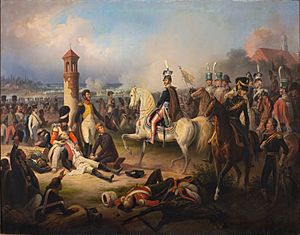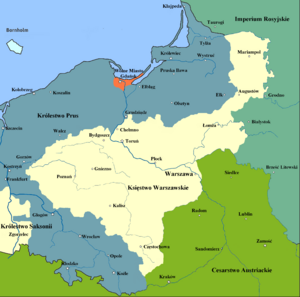Austro-Polish War facts for kids
Quick facts for kids Austro-Polish War |
|||||||||
|---|---|---|---|---|---|---|---|---|---|
| Part of the War of the Fifth Coalition | |||||||||
 Polish forces stops Austrian advance at Raszyn, only to retreat to the other side of the river soon afterwards. |
|||||||||
|
|||||||||
| Belligerents | |||||||||
Supported by |
|||||||||
| Commanders and leaders | |||||||||
| Strength | |||||||||
| 38,000 (initially) | |||||||||
The Austro-Polish War was a conflict in 1809. It was part of a bigger war called the War of the Fifth Coalition. This larger war involved the Austrian Empire and the United Kingdom fighting against Napoleon's French Empire and its allies.
In this war, Polish soldiers from the Duchy of Warsaw (a state allied with Napoleon) fought against the Austrian Empire. They were helped by troops from the Kingdom of Saxony. Later, the Russian Empire also joined the fight against Austria.
Polish forces successfully defended against an Austrian attack on Warsaw. They won a battle at Raszyn. Even though they later left Warsaw, they managed to take back parts of Poland that Austria had previously taken. This included important cities like Kraków and Lwów. This forced the Austrians to leave Warsaw and chase after the Polish army.
Contents
The War Begins: Austrian Invasion
The Duchy of Warsaw's army was weaker in 1808. This was because French soldiers stationed there had been sent to Spain. Only the Duchy's own Polish forces remained.
When the War of the Fifth Coalition started, Austrian troops invaded the Duchy of Warsaw. This happened on April 14, 1809. The Austrian forces were led by Archduke Ferdinand Karl Joseph of Austria-Este. They fought against the Polish defenders, who were led by Prince Józef Poniatowski.
Battle of Raszyn and Warsaw's Fall
The Battle of Raszyn took place on April 19. Prince Poniatowski's Polish troops faced an Austrian army twice their size. Neither side won a clear victory. However, the Polish forces decided to retreat. This allowed the Austrians to take Warsaw, the capital of the Duchy.
Poniatowski chose not to defend Warsaw directly. He believed the city would be too hard to hold. Instead, he wanted to keep his army moving. He crossed to the eastern side of the Vistula river. This way, he could fight the Austrians elsewhere.
The Austrians took Warsaw easily. But it was not a true victory for them. Their commander sent most of his soldiers to Warsaw. This left other battlefronts weaker. Ferdinand left 10,000 soldiers in Warsaw. He then split his remaining forces. Some went to the right bank of the Vistula. Others went towards Toruń and other places on the left bank.
Polish Counterattack and River Crossings
In a series of battles, the Polish forces defeated parts of the Austrian army. These battles included Radzymin, Grochów, and Ostrówek. The Austrians were forced to retreat to the western side of the river.
First, a large Austrian force tried to attack bridges in Praga, a suburb of Warsaw. About 6,000 Austrians had crossed the river. But 1,000 Polish defenders stopped them.
Soon after, General Michał Sokolnicki defeated the Austrian forces. These Austrians were trying to surround Praga. He first won the Battle of Grochów on April 26. Later, the Austrian army tried to chase Sokolnicki's Poles. But they were defeated on May 2 and 3 at the battle of Góra Kalwaria. In this battle, the Poles also destroyed the Austrians' partly built bridge. This gave the Poles control on the right bank of the river.
Polish Advance into Austrian Territory
In the following weeks, General Henryk Dąbrowski defended Greater Poland. Meanwhile, Prince Poniatowski left only a small group of soldiers to guard the Vistula bridges. He moved most of his army south.
Ferdinand tried a few more times to cross the Vistula. But the Polish forces stopped him each time. The Poles stayed close to the Vistula to control the situation. Then, they invaded the weakly defended Austrian territory to the south. They attacked the Austrian forces from behind. They took parts of Poland that had been taken by Austria in earlier partitions.
Polish forces captured important cities like Lublin (May 14), Sandomierz (May 18), Zamość (May 20), and Lwów (May 27). A Polish government and military groups were quickly set up in these areas. Generals Jan Henryk Dąbrowski and Józef Zajączek led the units that slowed down the Austrians on the western side of the Vistula.
Eventually, the main Austrian army, led by Archduke Ferdinand, could not advance further. Their supply lines were also in danger from Poniatowski's army. So, they had to stop trying to capture Toruń. They also left Warsaw on June 1. They moved south, hoping to fight the Polish army in Galicia. They also planned to join up with the main Austrian army further west. Poniatowski decided not to fight the Austrian forces directly. Instead, he focused on taking as much of Galicia as possible.
Russia's Role
On June 3, Russian forces also crossed into Austrian Galicia. They wanted to stop the Poles from becoming too strong. They also hoped to take some Austrian lands for themselves. Russia was supposed to help France if Austria broke the peace treaty. But Russian and Austrian forces still saw each other as allies. The Russian commander, Sergei Golitsyn, was told to help the Poles as little as possible.
The Austrians managed to defeat Zajączek at the Battle of Jedlińsk on June 11. They also took back Sandomierz (June 18) and Lwów. But they could not catch Poniatowski. He had taken Kielce and Kraków (July 15) in the meantime. Zajączek's soldiers joined Poniatowski's on June 19. Dąbrowski's and Sokolnicki's forces joined them on July 3 and 4. The French army finally stopped and defeated the Austrians at the Battle of Wagram (July 5–6).
Aftermath of the War
General Józef Poniatowski became a national hero in Poland after this war. Napoleon even gave him a special sword for his victories.
After the war, the Treaty of Schönbrunn was signed. Most of the land that Polish forces had taken back was given to the Duchy of Warsaw. This land had been taken by the Austrian Empire during the partitions of Poland many years before.


